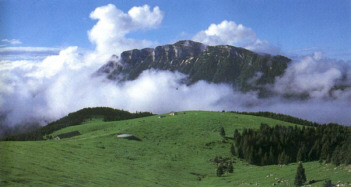

STOP VIII

Asiago Town Square
|
Asiago –
l'Altopiano dei Sette Comuni
By Richard Galli
|
Asiago has two definitions- the Trentino highlands or Altopiano, and the Sette Comuni or Seven Communities. Asiago is also the name of the largest of the seven communities. The Altipiano is a natural citadel on a rugged highland plateau between the snowy Alps [to the north, east and west] and the rich Venetian plain [to the south.] It can be considered plateau only when compared to the towering Alps, for the Altipiano itself has mountains covered with dense coniferous forests and alpine meadows. Surrounded by an enormous escarpment, often of cliffs a thousand meters in height, the Altipiano rises from the lowland plains in only a few kilometers.

The Altipiano is mountain, meadow and deep forest
Since prehistoric times, the Altipiano has been home to the Cimbri people, a nomadic Bavarian tribe. The Cimbri have lived in harmony between the Austrian Tirol and Italian Veneto, trading in wool, cheese and timber. These goods were carried down to the Brenta river valley on the amazing La Cala del Sasso, a medieval pathway of 4,444 wide stone steps. Avoiding conquest by both diplomacy and isolated wilderness, the Cimbri had an independent state from 1310 to 1807. Each of the seven communities is a treasure in itself, with an individual culture, history and identity. Their ancient Germanic language is reflected in place and surnames, as well as the communities themselves: Asiago- Sleghe, Lusiana- Lusaan, Enego- Genwhe, Foza- Wusche, Gallio- Ghel, Rotzo- Rotz, and Roana-Robaan. Asiago has always been the primary community in government, commerce and society by geography (it is in the very middle of the Altipiano) and topography (Asiago is surrounded by the largest meadows and is sheltered from the worst of winter storms.)

Asiago Under Siege
In the 19th Century the area was divided between the Kingdom of Italy and the Austro-Hungarian Empire. Each community, by boundary and imperial policy, took on a more Austrian or Italian identity. To make matters worse, modern warfare viewed the Altopiano as an avenue of invasion, as opposed to ancient routes along the Adige or Brenta River valleys. Both nations built a string of modern fortresses across the plateau. The Austrian Emperor Franz-Josef called his forts "the iron girdle." These structures were not the outdated brick, earth and stone forts of France or Belgium, hastily reenforced with a concrete shell and iron turrets. Both Austrian and Italian forts were modern, of solid concrete, reinforced with iron, incorporating the latest military technology. The first shots of the war between Austria and Italy were fired on the Altipiano. The Austrian forts proved their value in withstanding every Italian attack. Asiago, and most of this Trentino highland, were overrun by the Austrians twice- in the Spring Offensive of 1916 [also known as the Strafexpedition or "punishment war"] and the Fall Offensive of 1917. The latter is associated with the Battle of Caporetto and is called La Battaglia degli Altipiani by Italian historians. Other major battles on the plateau include the Italian counteroffensive of June 1916, Ortigara in June 1917 [see article on the Virtual Tour], the Austrian offensive of June 1918 [also called " the Battle of the Solstice or the Battle of the Piave"] and the final rout/retreat of the Austrians in October 1918. The Austrians never once broke out of the confines of the Altipiano onto the open plains of Veneto, due to fierce Italian resistance, the rough terrain and an influenza epidemic in the Austrian ranks during the Winter of 1917/18.

Sacrario Militare (Ossario) |
Evidence of these horrific battles increases as a person travels onto the Altipiano, especially above the timberline. Lower forests and meadows have absorbed the remains of war, as across all of Europe. Atop any ridge or peak however, the scars of trenches and shellholes can still be seen below. The fortresses were for the most part demolished (for iron) during the impoverished Thirties- destroyed more by scavenging than war! Fort Belvedere [formerly Gschwent] has been restored to its old stature, and is now a museum. On the scared rocky peaks of Ortigara it appears as if the battle ended only last year. Across these forests and meadows are the graveyards of Italian, Austrian and British troops who have found their final resting place. Some burials contain hundreds of men, others only one or two. In Asiago, Sacrario Militaire, the tomb of over 51,000 identified and unknown Italian and Austro-Hungarian soldiers, includes twelve soldiers awarded Italy's highest decoration di Medaglia d'Oro al Valor Militare. As with all ossuaries in Italy, Il Sacrario is being added to yearly, as hiker, farmer and forester find new remains.

Scenes from War on the Altipiano
L: Italian Casualties in Asiago;
R: Scottish Troops on the Plateau: Sent by Allies after Caporetto
Today Asiago and the Altipiano is known worldwide for its excellent cheeses and grappa, as well as regionally for outdoor sports ranging from the tranquility of golf or cross-country skiing, to the extreme in paragliding or back-country skiing. The area is discrete in its tourism- wandering for nature, mushrooms, or history can all be done in solitude. The Cimbri retain their pride in culture and survival; in the Altipiano, the mixture of Germanic and Latin encountered is ancient, not post-1918. Asiago has much to offer in year-round festivals, the arts and the spectrum of history- it is the traveler's choice. Last but not least, there are also several splendid guidebooks that study the Great War on the Altipiano, museums at Il Sacrario and Canove di Roana, the old forts, cemeteries and battlefields. Everywhere across the Asiago plateau are reminders of the region's depth of involvement in La Grande Guerra.
|
Sources and Thanks: Contributor Richard Galli provided all the photos for his article
|

|








